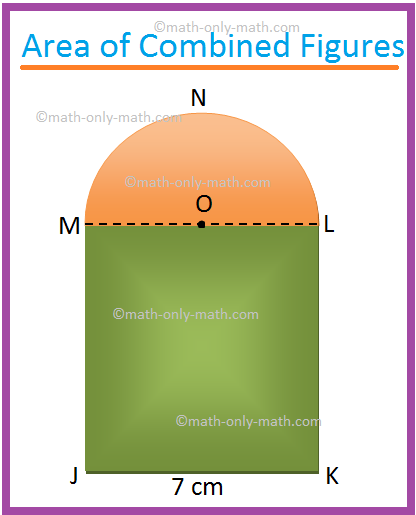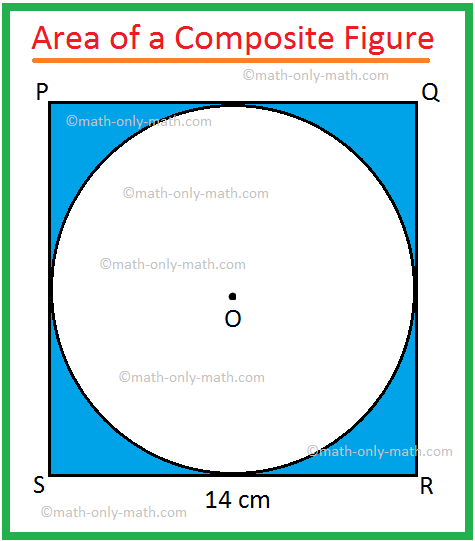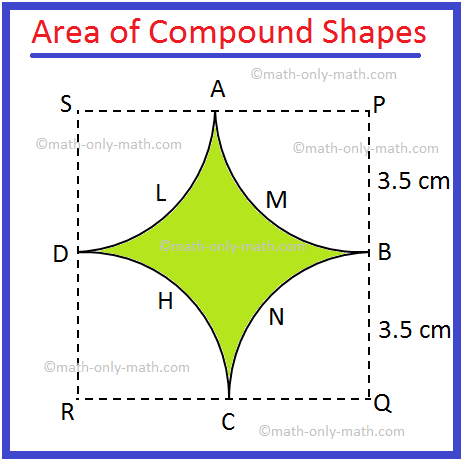Subscribe to our ▶️ YouTube channel 🔴 for the latest videos, updates, and tips.
Area of Combined Figures
A combined figure is a geometrical shape that is the combination of many simple geometrical shapes.
To find the area of combined figures we will follow the steps:
Step I: First we divide the combined figure into its simple geometrical shapes.
Step II: Then calculate the area of these simple geometrical shapes separately,
Step III: Finally, to find the required area of the combined figure we need to add or subtract these areas.
Solved Examples on Area of combined figures:
1. Find the area of the shaded region of the adjoining figure. (Use π = \(\frac{22}{7}\))
JKLM is a square of side 7 cm. O is the centre of the
semicircle MNL.
Solution:
Step I: First we divide the combined figure into its simple geometrical shapes.
The given combined shape is combination of a square and a semicircle.
Step II: Then calculate the area of these simple geometrical shapes separately.
Area of the square JKLM = 72 cm2
= 49 cm2
Area of the semicircle LNM = \(\frac{1}{2}\) π ∙ \((\frac{7}{2})^{2}\) cm2 , [Since, diameter LM = 7 cm]
= \(\frac{1}{2}\) ∙ \(\frac{22}{7}\) ∙ \(\frac{49}{4}\) cm2
= \(\frac{77}{4}\) cm2
= 19.25 cm2
Step III: Finally, add these areas up to get the total area of the combined figure.
Therefore, the required area = 49 cm2 + 19.25 cm2
= 68.25 cm2.
2. In the adjoining figure, PQRS is a square of side 14 cm and O is the centre of the circle touching all sides of the square.
Find the area of the shaded region.
Solution:
Step I: First we divide the combined figure into its simple geometrical shapes.
The given combined shape is combination of a square and a circle.
Step II: Then calculate the area of these simple geometrical shapes separately.
Area of the square PQRS = 142 cm2
= 196 cm2
Area of the circle with centre O = π ∙ 72 cm2, [Since, diameter SR = 14 cm]
= \(\frac{22}{7}\) ∙ 49 cm2
= 22 × 7 cm2
= 154 cm2
Step III: Finally, to find the required area of the combined figure we need to subtract the area of the circle from the area of the square.
Therefore, the required area = 196 cm2 - 154 cm2
= 42 cm2
3. In the adjoining figure alongside, there are four equal quadrants of circles each of radius 3.5 cm, their centres being P, Q, R and S.
Find the area of the shaded region.
Solution:
Step I: First we divide the combined figure into its simple geometrical shapes.
The given combined shape is combination of a square and four quadrants.
Step II:Then calculate the area of these simple geometrical shapes separately.
Area of the square PQRS = 72 cm2, [Since, side of the square = 7 cm]
= 49 cm2
Area of the quadrant APB = \(\frac{1}{4}\) π ∙ r2 cm2
= \(\frac{1}{4}\) ∙ \(\frac{22}{7}\) ∙ \((\frac{7}{2})^{2}\) cm2, [Since, side of the square = 7 cm and radius of the quadrant = \(\frac{7}{2}\) cm]
= \(\frac{77}{8}\) cm2
There are four quadrants and they have the same area.
So, total area of the four quadrants = 4 × \(\frac{77}{8}\) cm2
= \(\frac{77}{2}\) cm2
= \(\frac{77}{2}\) cm2
Step III: Finally, to find the required area of the combined figure we need to subtract the area of the four quadrants from the area of the square.
Therefore, the required area = 49 cm2 - \(\frac{77}{2}\) cm2
= \(\frac{21}{2}\) cm2
= 10.5 cm2
From Areas of Combined Figures to HOME PAGE
Didn't find what you were looking for? Or want to know more information about Math Only Math. Use this Google Search to find what you need.





New! Comments
Have your say about what you just read! Leave me a comment in the box below. Ask a Question or Answer a Question.